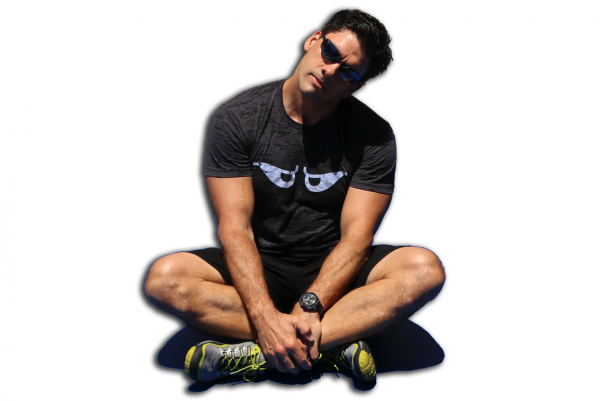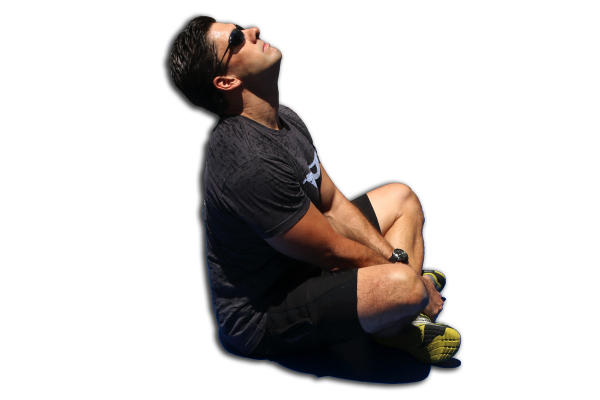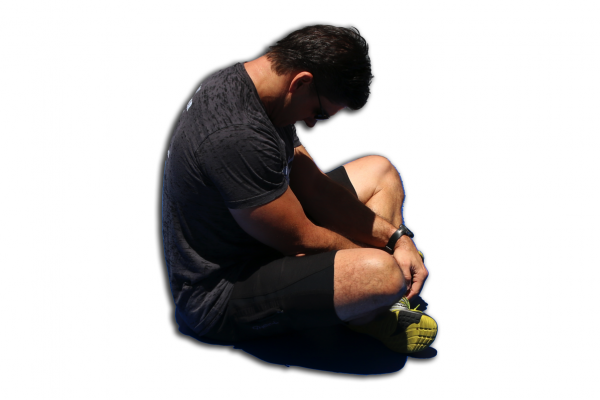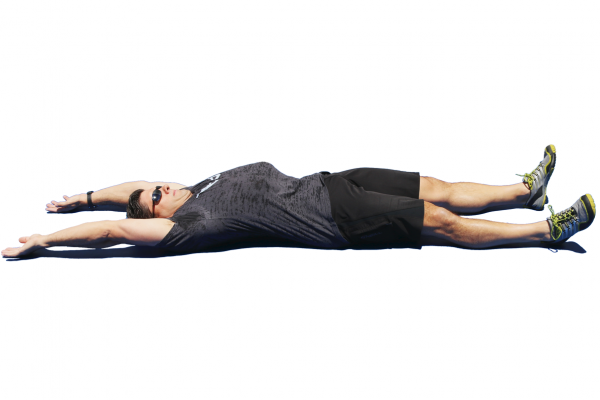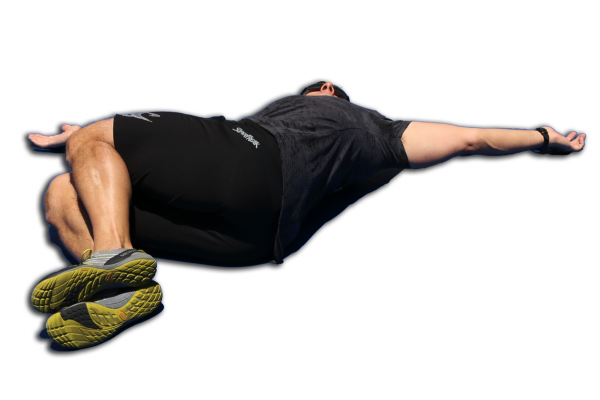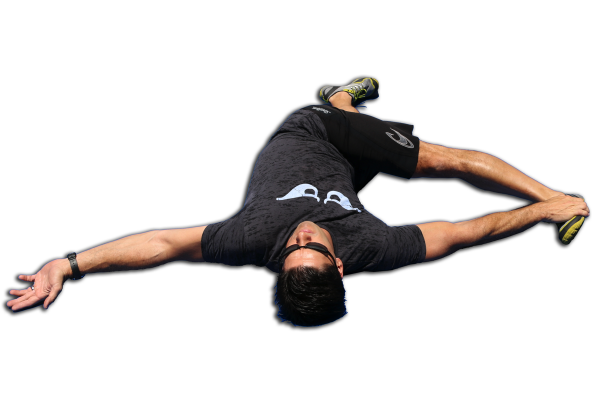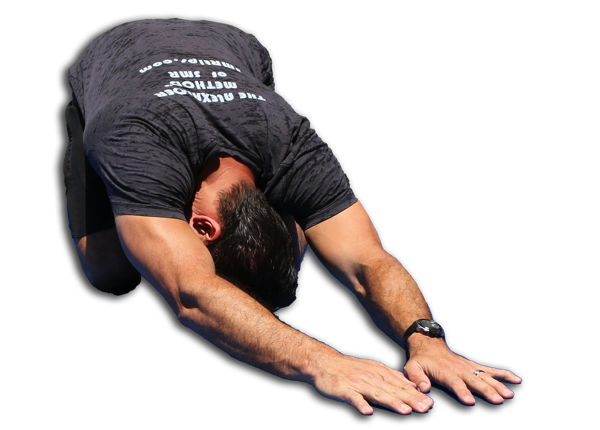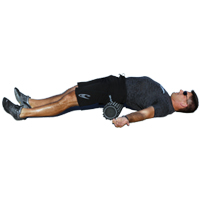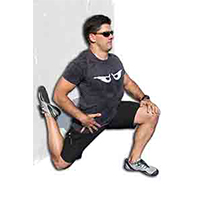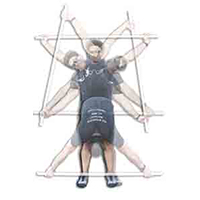Functional Movements
Below are links to printable instructions and video downloads of functional movements we recommend to get the most out of your SMR efforts. Portions of the movements below can be separated into individual stretches, and we encourage you to chop them up into little sequences as needed.
When you are ready feel free to combine the movements below (and a few from above) into a routine as a warm up prior to a workout. The movements below are primarily warm-up techniques intended to better establish how well you can coordinate your movements, not necessarily to increase the ROM possible at any joint. To dramatically increase your ROM spend more time with the stretches listed above and allow your muscles time (2-5 minutes) to actually lengthen.
Stretching quickly is not likely to increase your muscle length, but quick movements are a good way to remove light restrictions between tissues, which will allow you to move better. For your best results do some slow stretches at times and do some faster functional movements other times as part of your program.
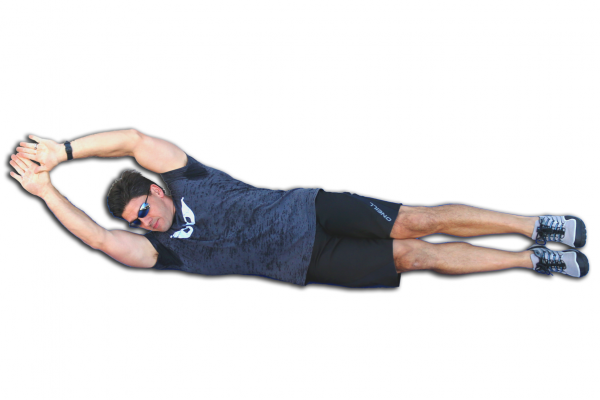
1) Banana Rolls, click here.
This movement is like combining the two functional movements Supermans (pictured below) and Hollow Rockers (coming soon) into one technique, along with some core rotation work.
The general idea is to begin either on your stomach or back, lift your elbows and knees off the ground, and roll over without touching the ground with your arms or legs.
This is GREATwarm-up drill for the entire core, and it's kinda fun too!
Video coming soon.
Read more
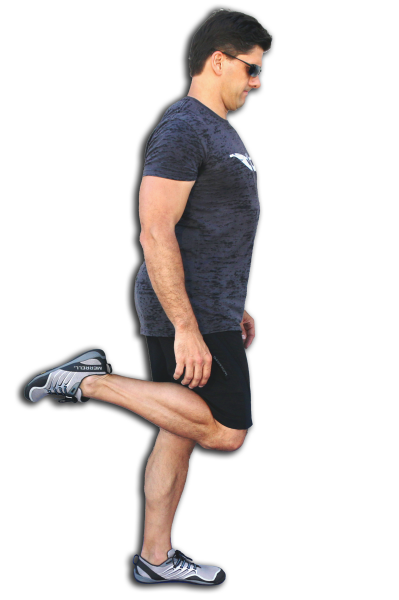
2) Butt Kickers, click here.
This movement is normally practiced as a quick-paced movement somewhat like a jog, in which you repeatedly attempt to kick your own rear-end with your heels as you do about 20 paces.
In the picture at right Jeff is standing in one place, not alternately hopping onto either foot. As you practice this movement quickly, you would likely not allow your heel to touch the ground but instead stay on the ball of your standing foot.
Video coming soon.
Read more
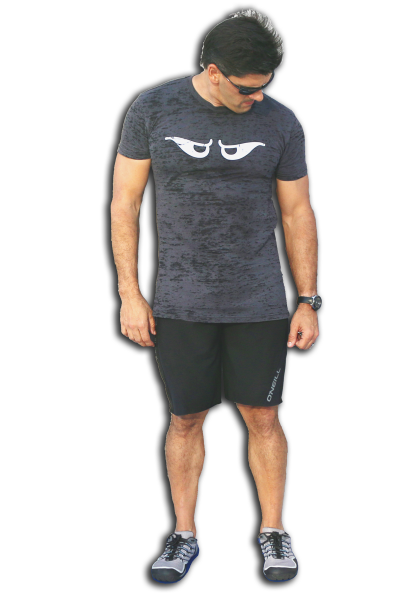
3) Chin to Clavicles, click here.
This is primarily an assessment movement for cervical erector ROM and is normally practiced slower than the Banana Rolls or Butt Kickers, but should not be held on either side for more than 1 second.
If you hold your chin against either clavicle for a lengthy period of time you will likely exhaust your cervical flexors quite quickly. If you already have some fatigue issues in these muscles then you could be creating more problems for yourself.
This movement is a good assessment following any cervical erector SMR techniques like the Neck Roll or Levator Floor Press to verify you did the technique correctly and are improving your ROM.
If you cannot touch your chin to your clavicle you likely need lots of neck work, both SMR and stretches, and may need some professional hands-on care to return to full functional ROM.
Video coming soon.
Read more
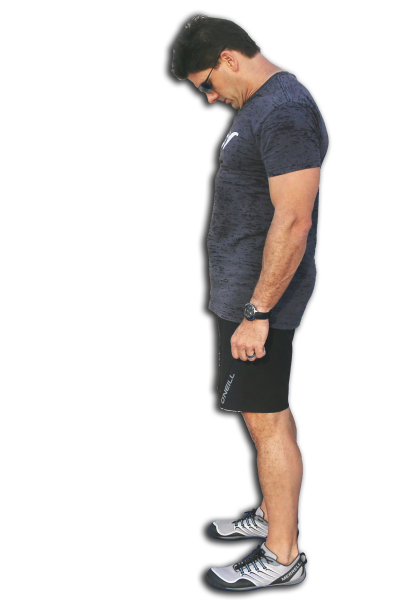
4) Chin to Sternum, click here.
This is primarily an assessment movement for cervical erector ROM and is normally practiced slower than the Banana Rolls or Butt Kickers, but should not be held for more than 1 second.
If you hold your chin against your sternum for a lengthy period of time you will likely exhaust your cervical flexors quite quickly. If you already have some fatigue issues in these muscles then you could be creating more problems for yourself.
This movement is a good assessment following any cervical erector SMR techniques like the Neck Roll or Levator Floor Press to verify you did the technique correctly and are improving your ROM.
If you cannot touch your chin to your sternum you likely need lots of neck work, both SMR and stretches, and may need some professional hands-on care to return to full functional ROM.
Video coming soon.
Read more
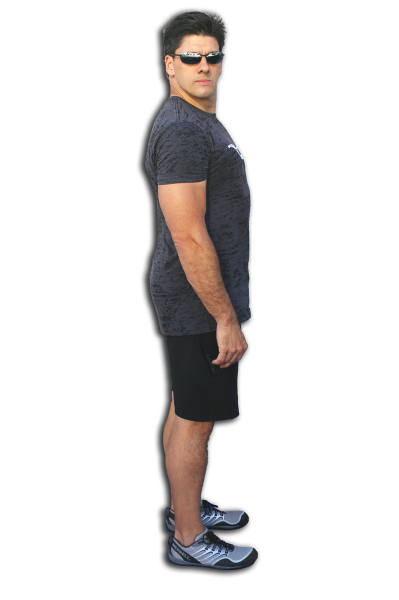
5) Chin toward Shoulders, click here.
This is primarily an assessment movement for Levator Scapulae ROM and is normally practiced slower than the Banana Rolls or Butt Kickers, but should not be held for more than 1 second.
If you hold your chin turned to the side for a lengthy period of time you will likely exhaust several of your neck muscles quite quickly. If you already have some fatigue issues in these muscles then you could be creating more problems for yourself.
This movement is a good assessment following any cervical erector SMR techniques like the Neck Roll or Levator Floor Press to verify you did the technique correctly and are improving your ROM.
You may need some professional hands-on care along with your self-care efforts to return to full functional ROM.
Video coming soon.
Read more
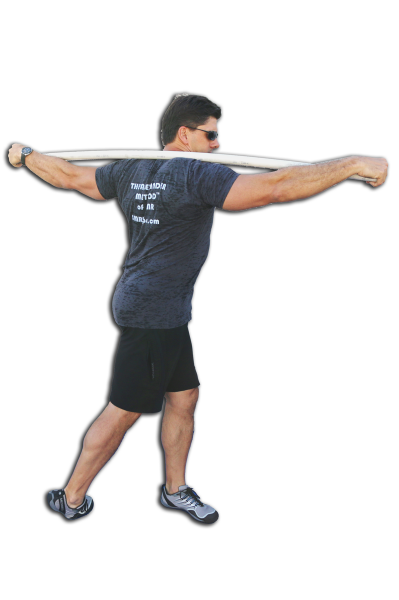
6) Core Twists, click here.
This movement is typically practiced rather quickly, but can be held at full rotation to accomplish a deeper stretch of the anterior shoulder muscles for the side to which you are turning.
One key point is to pay attention to your feet...your trailing foot should point at your leading foot (the foot for the side you are turning toward should not rotate). this will guarantee you are activating your hip flexors along with your obliques and coordinating the muscles across your hips and core properly. Keeping your feet parallel as you turn disconnects your hips from your torso and is not recommended. You protect your lower back best when your hip and core muscles work together like a team.
Video coming soon.
Read more
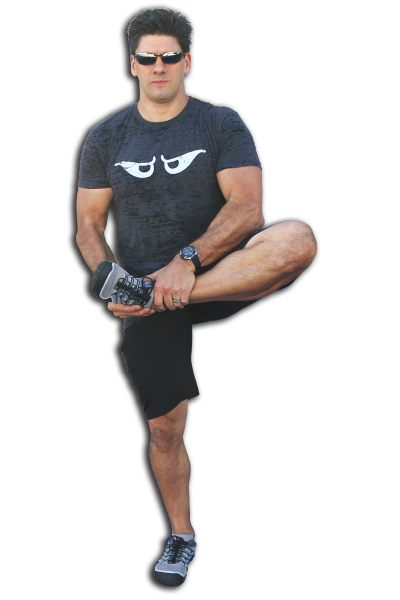
7) Cradles, click here.
This movement is normally practiced as a quick-paced movement somewhat like a jog, but a little slower than Butt Kickers, in which you repeatedly grab your foot and pull it as close to your pubic bone as possible as you do about 20 paces.
In the picture at right Jeff is standing in one place, not alternately standing on either foot. As you practice this movement you would likely not allow your heel to touch the ground but instead stay on the ball of your standing foot.
Video coming soon.
Read more
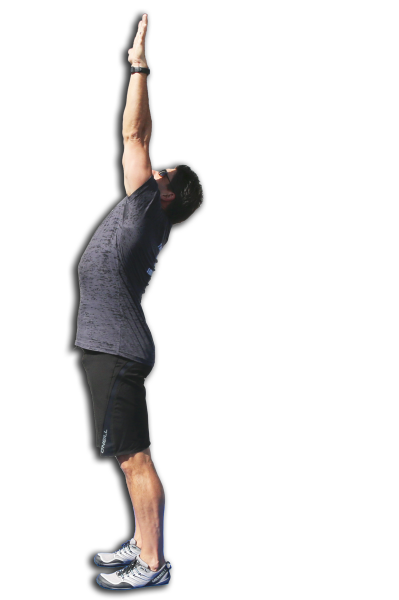
8) Floor to Sky, click here.
"Sun Salutation," "Floor to Sky," or any name you wish to call this movement, the idea is pretty simple: bend over and reach for the ground then stand up and reach as high overhead as possible. The intention is to wake up almost every muscle in your body.
This movement is normally practiced several times with a slight pause at either end. It is not usually practiced very fast.
Video coming soon.
Read more
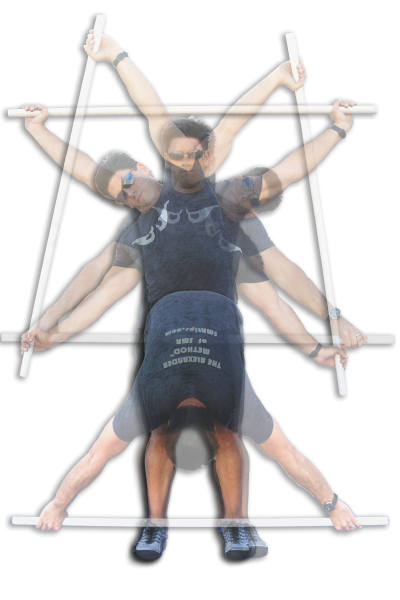
9) Giant Around the Worlds, click here.
If you combine Pass Thrus (listed below) with Around the Worlds (coming soon) and Floor to Sky (listed above) you get Giant Around the Worlds...an exercise that targets the hips, torso and shoulders.
The idea is that you grab a very light-weight dowel (stick) with a wide grip and bend over as far forward as you can...take a moment to reach for the ground and feel the muscles along the backs of your legs and torso "let go" for just a moment.
Then stand and lean toward one side as you press the dowel almost vertical along side of you and feel all the muscles from your shoulder to your hip of the opposite side "let go." Then reach behind you (keep the stick above your shoulders) and lean back as far as possible...look at the sky and feel all the muscles along the front of your hips and core "let go." Then press the stick out toward your other side as you feel the muscles from your other shoulder to your hip "let go." Then repeat a few times.
Then go the other direction.
Afterward you should feel everything around your hips and core moving better and ready for some more challenging movements.
Video coming soon.
Read more
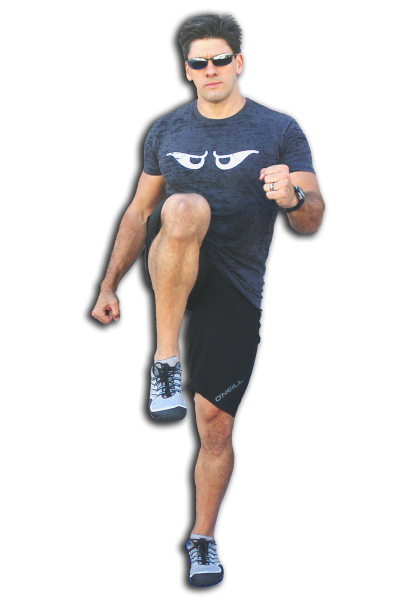
10) High Marching, click here.
Pick up one knee as high as is possible with neutral spine. Switch legs. Do it again 10-20 times.
This is a rather simple drill to warm-up and possibly test balance.
This can be a good assessment for improvements in hip flexor function following the Psoas Press SMR technique (you should be able to raise your knee higher with less effort afterward).
Video coming soon.
Read more
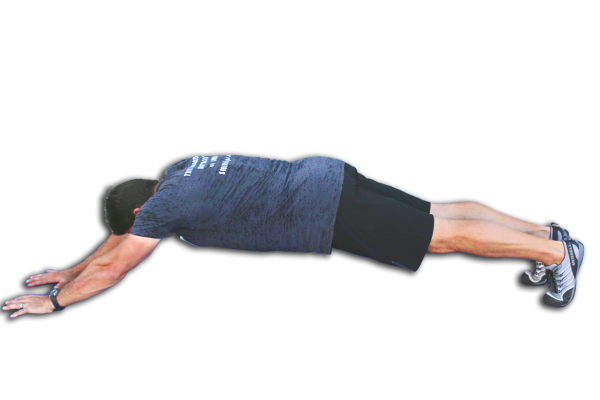
11) Inchworms, click here.
This movement is kind of like a moving push up with Downward Dog (not listed) in between each push up.
From a standing position bend over and touch your toes (bend your knees if necessary). Walk your hands out as far as possible (beyond a push up position is preferred, but keep your torso off the floor). Without bending your knees walk from the ankles and get your feet as close to your hands as possible. Hold for a brief moment to feel the stretch along the backs of your legs, then repeat 5-10 times.
Video coming soon.
Read more
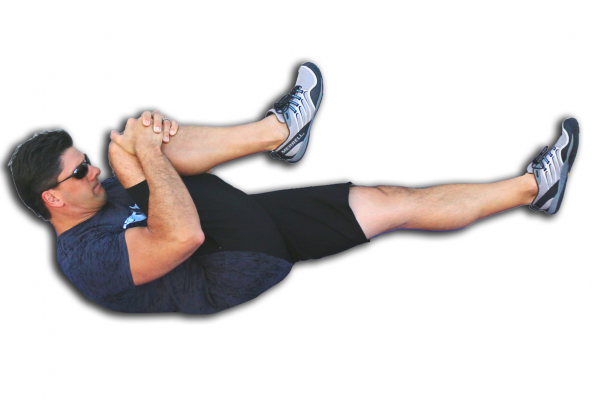
12) Knee Hugs, click here.
This movement is sometimes practiced only a few slower reps, and other times is practiced quickly for many reps...it's up to you how you wish to perform it.
Lay on your back. Lift your head and legs and keep them off the ground. Alternate grabbing your knee and puling it as close as possible to your head. Repeat as many times as preferred.
Can be a good warm-up or cool-down movement, all depending on how you do it.
Video coming soon.
Read more
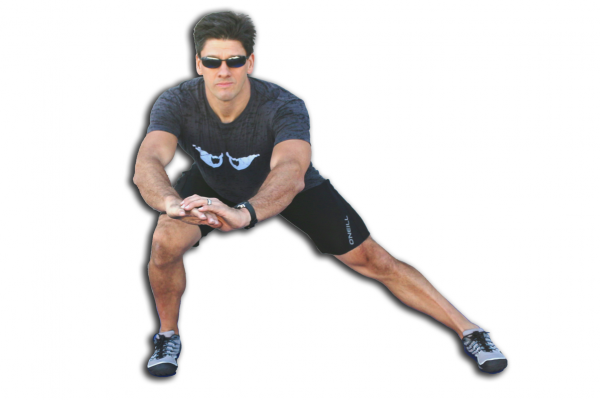
13) Lateral Lunges, click here.
This movement is sometimes performed slowly as a dynamic stretch, and other times performed more quickly as a coordination warm-up drill. Try both.
When performing it as a stretch, take a moment in the lunge position and press your hips back so that you can feel your adductor and hamstring muscles lengthening along the trailing leg. Moving too quickly makes it unlikely you will achieve any significant stretch.
When performing this movement quickly try to stay in constant motion. Not hurried, but steady and fluid. Work on feeling your balance throughout the entire process and try to feel your torso "float" along as you move your legs under you.
For video of how to do the Lateral Lunge, click here. New video coming soon.
Read more
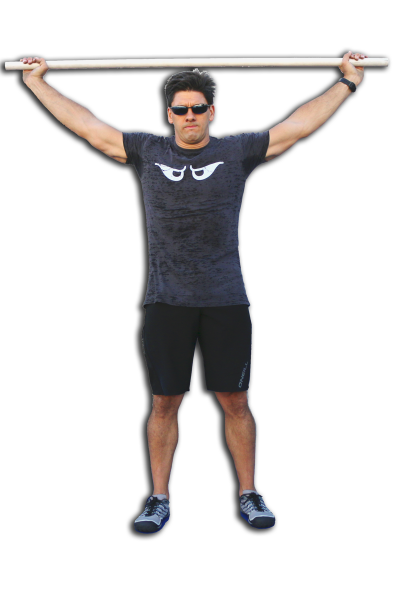
14) Pass Thrus, click here.
This movement is often performed far too fast to ever be an effective stretch. Fast is not bad...but by performing this movement both quickly some times and slowly other times you can find benefits you would never otherwise discover.
The most critical position when performing this movement slowly as a stretch is when you have the stick behind your head but above your shoulders. This 12-to-3 position will best target the musculature that tends to tighten the fronts of your shoulders and pull your shoulders in toward the center of your chest. If you struggle with internal rotation issues or have difficulty with overhead positions with weights, spend a little extra time with the stick in this 3/4 position as you explore the potential to open up those tight shoulders.
The closer your hands are to each other on the stick the more difficult this movement is. It is not necessary to touch the stick to your lower back or hips behind you. As your shoulders limber up you will notice an easier time rotating the stick all the way around you either direction.
Video coming soon.
Read more
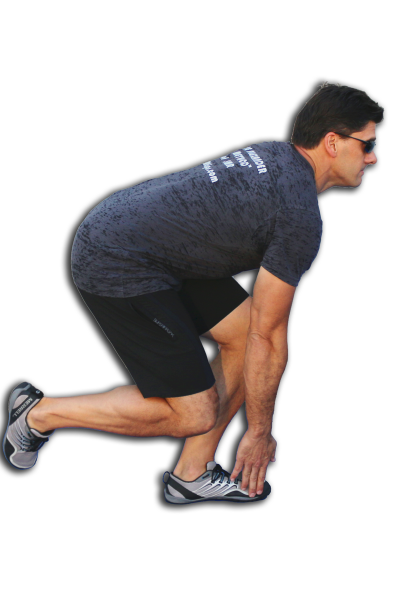
15) Single Leg Deadlifts, click here.
Many people have a tendency to "reach" with their hand as they attempt this movement, and they lose neutral spinal alignment as they do so. The goal is to maintain proper spinal alignment as you lower your hand as close as possible to the opposite foot. If you can reach your foot, great, but only while maintaining a neutral spine.
Keeping a neutral spine during both the down and up phases of this movement reinforces utilizing your hip and leg to lower and raise your body, rather than your spinal flexors and erectors. So many adults "lift with their back," and this one exercise is a good way to undo that habit.
Video coming soon.
Read more
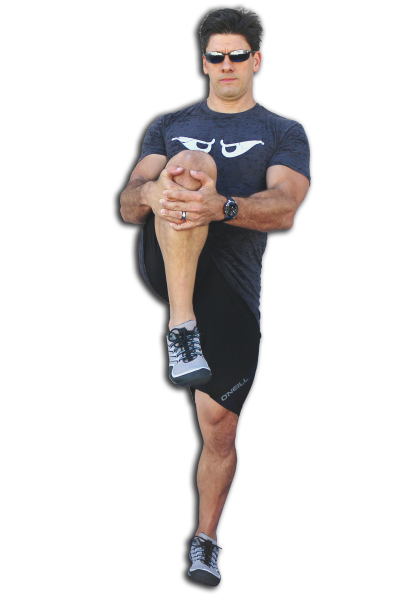
16) Standing Knee Hugs, click here.
At first glance this movement looks like a more aggressive version of High Marching (listed above).
It is actually a good dynamic stretch for the leg you grab and a good warm up drill for the standing leg, all in one movement.
If you hold the "pull" of each leg for a moment you can really feel your legs limber up with each repetition.
To also warm up your calves try standing on your toes as you pull each leg.
Video coming soon.
Read more
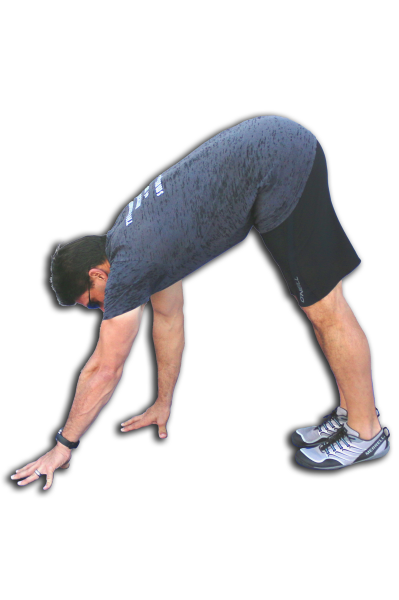
17) Stationary Inchworms, click here.
This movement is very similar to the Inchworms (listed above), except that with this movement you do not move your feet.
While keeping your feet in place, walk your hands out as far as possible without allowing your torso to touch the floor. Without bending your knees walk your hands back as close to your feet as possible.
Hold the position with your hands close to your feet and your knees straight for a short period to get a good stretch along the backs of your legs, or quickly walk back out into another inchworm for more shoulder and core activation.
Video coming soon.
Read more
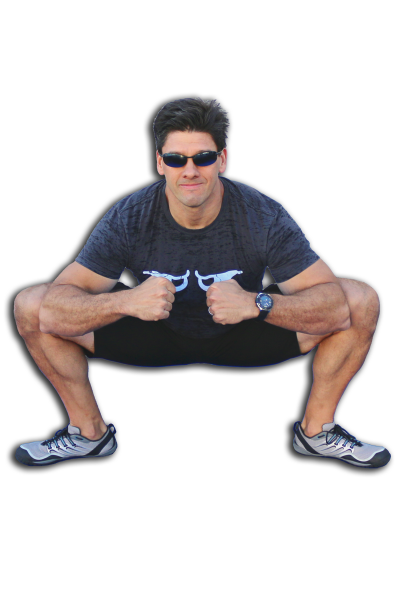
18) Sumo Squat Knees, click here.
The objective of this movement is to limber up your adductors.
Some experts want you to squat with your "toes forward" and we typically agree. In this particular case though, we want your toes turned as far toward the sides as your flexibility allows. Think Mary Poppins, but with a wide stance. The wider the better.
In the bottom of the squat use your elbows to press your thighs out even wider. Hold the bottom for a moment to allow those tight adductors a chance to loosen up. Stand, shake your legs out if necessary, then repeat 5-10 times.
Video coming soon.
Read more
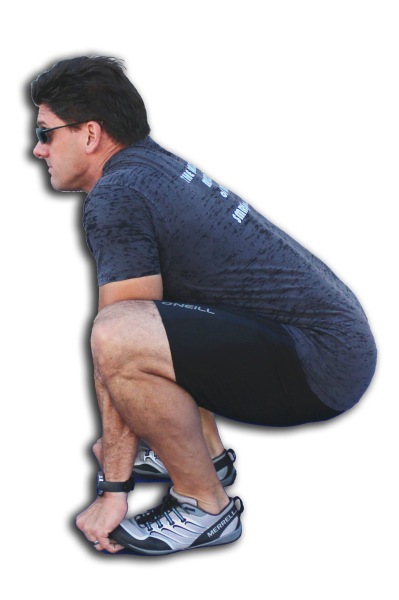
19) Sumo Squat Toes, click here.
The Sumo Squat Knees (listed above) focuses on your adductors. This movement focuses on your hamstrings.
With about a shoulder-width stance, squat down and grab your toes with your arms inside of your knees. Slowly press your knees as straight as possible without rounding your back. Hold for a short time and then resume the squat position. Repeat 5-10 times.
This version of a Sumo Squat tends to be more difficult than the wider stance one. If you have a lot of trouble with this one be sure you spend some time working on the hamstring stretches and SMR techniques in addition to practicing this movement as often as possible.
Video coming soon.
Read more
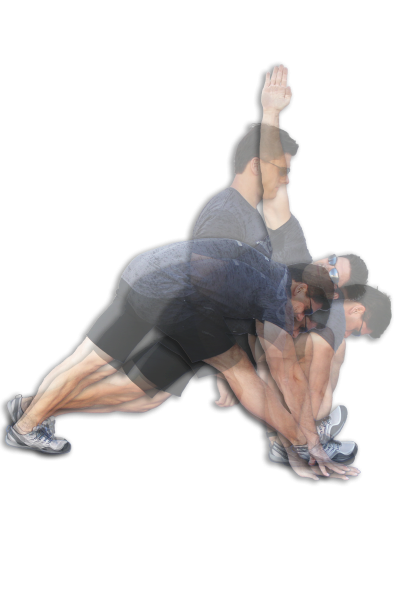
20) Superlunges, click here.
Counting the start position, this movement has many steps. Initially the most important steps are the ones that stretch the hamstrings. Although this movement can be performed quickly as a warm-up drill, until you can comfortably perform each step with full ROM it is best to perform this movement as a series of stretches strung together. Take your time to get your best results.
The movement progresses basically like this: 1) From a standing position take a very large step. 2) Place your opposite hand alongside your instep of the forward foot. 3) Rotate your chest toward your forward knee and stack your arms vertically while you keep your knee over your foot (don't let your hip rotate as you turn your chest toward your knee). 4) Rotate your chest to face the floor while you place one hand on the floor on either side of your forward foot. 5) Without raising your hands off the floor, straighten your forward knee so both legs are straight. 6) Raise your forward toes off the floor with your hands on either side of your forward foot and both legs straight. 7) Return to a standing position and repeat for the other leg.
Step 6 above is the most important to improve hamstring flexibility. Even if you kneel on your back knee you can get a wonderful stretch on the forward hamstring if you place your hands on the floor on either side of your forward leg and draw your toes toward your shin.
Video coming soon.
Read more
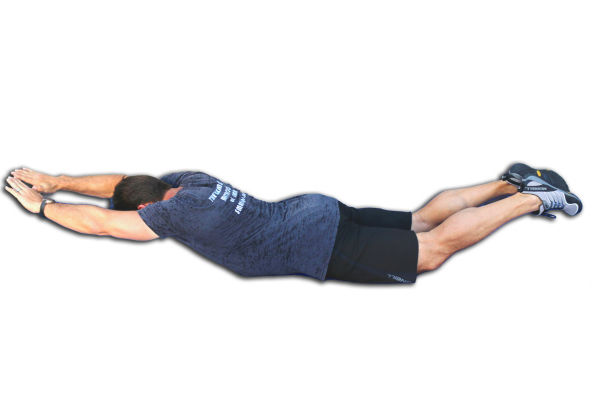
21) Supermans, click here.
This movement is part of the Banana Rolls (listed above).
Lay on your stomach. Lift your elbows above your ears and your knees off the ground. Relax and rest on the floor. Repeat 5-50 times.
This movement tends to be a conditioning/coordination movement done for many reps once you have the strength and flexibility to perform it properly. Feel free to challenge yourself to see how many reps you can do.
Video coming soon.
Read more
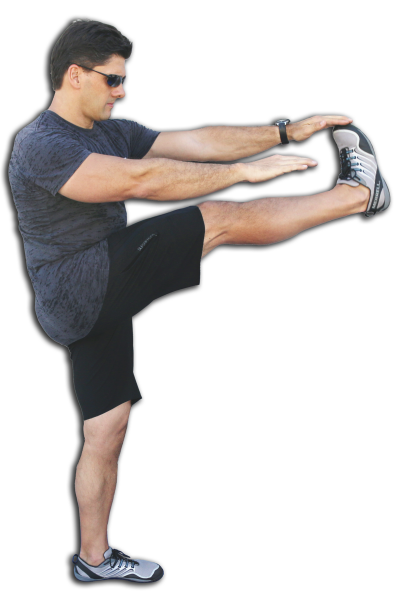
22) Toy Soldiers, click here.
This movement is a more advanced version of High Marching (listed above).
One common fault when performing this movement is to kick the same-side hand with your foot. Athletically you should pull your opposite hand toward your kicking foot to activate your hip flexors and core muscles.
Without dramatically kicking across your midline, bring your opposite hand toward your kicking foot. Whether you make contact with your foot is not as important as keeping your spine neutral (don't bend forward) and your knee as straight as possible.
Video coming soon.
Read more
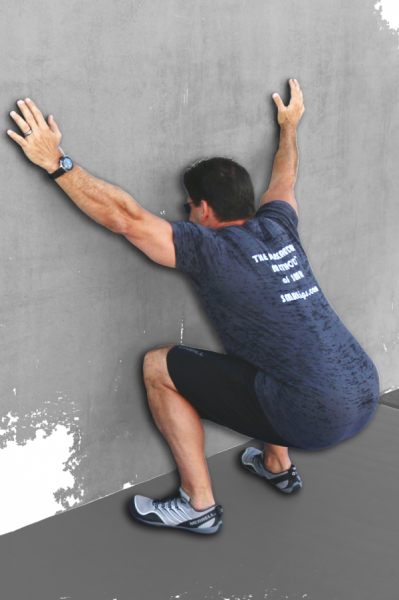
23) Wall Squats, click here.
At first glance this movement may appear to be intended to loosen up your legs. True, if your legs are tight then you will need to work on them to get the most out of this movement.
However, this movement is actually to limber up your shoulders and back. The tighter your pecs and lats are the more difficult it will be to descend below parallel with your hips while keeping your arms overhead against the wall.
The closer your hands are together and the closer your toes are to the wall the harder this movement is to perform. Try various distances and work on getting closer with both. Five slow reps will provide you with faster progress than many fast ones (muscles do not stretch very well when you move quickly).
For video of how to do the Wall Squat, click here. New video coming soon.
Read more
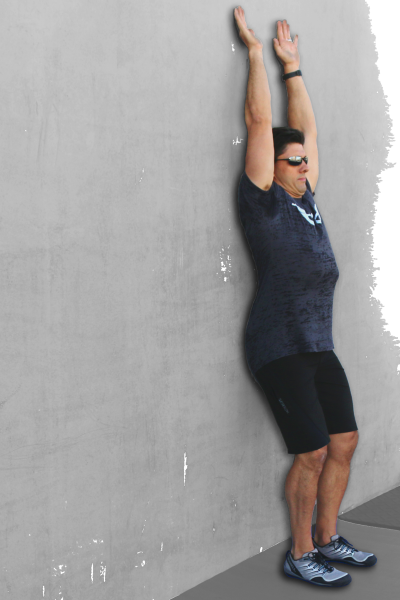
24) Wall Touch, click here.
This movement is a more advanced version of the Floor Touch stretch (listed above).
The primary advantage of performing the Wall Touch instead of the Floor Touch as an assessment following the Lats Roll or Pecs Roll (or Presses) is that by being upright you must fight the pull of gravity to lift your arms overhead, whereas when you are lying down you do not need to activate any muscles after a certain point for your arms to move higher overhead.
By requiring you to activate most of the muscles attached to your shoulders, when you perform this movement you can more easily spot coordination dysfunctions and potential areas for more SMR/stretching...elbows far away from your ears? Work on your Triceps...Arms forward away from the wall? Work on your pecs...Arms wide away from your body and have trouble touching the wall? Work on your Lats.
It is not necessary to perform many repetitions of this movement. The primary purpose is to assess shoulder ROM.
Video coming soon.
Read more
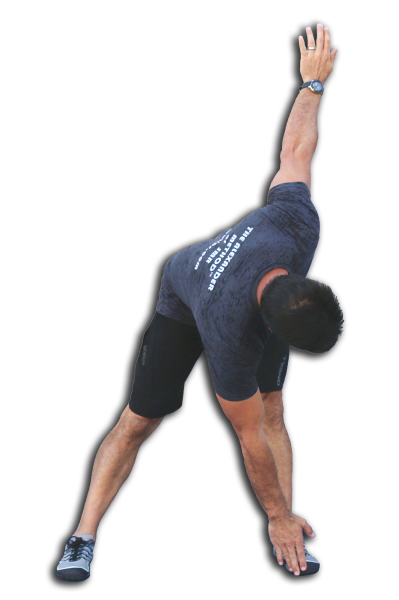
25) Windmills, click here.
If you have healthy hip ROM this movement is reasonably safe for you to perform. If you flex your spine instead of your hips when attempting this movement then you might injure your back while performing it, and you should pick a different exercise.
You may wish to perform only a few repetitions to stretch your torso, legs, and hips, or you may wish to perform many as a warm up.
So long as you keep your spine in a neutral position pick whichever your like.
Video coming soon.
Read more
|
